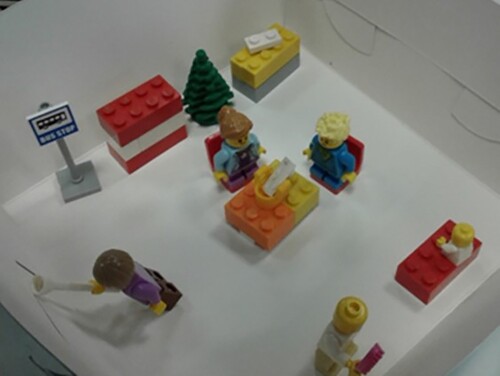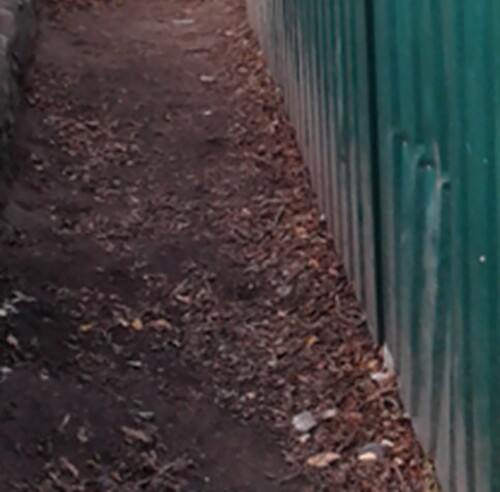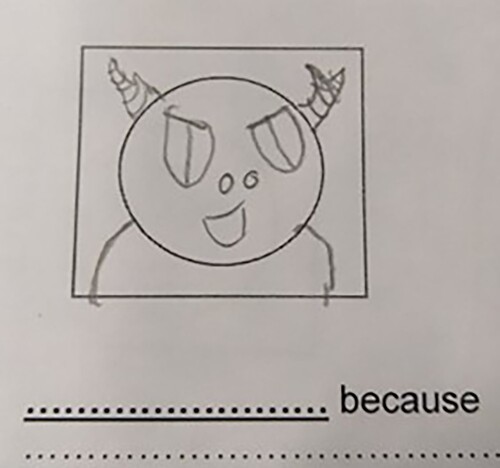ABSTRACT
Autistic children face significant barriers to having their views listened to in research. Inaccessible research encounters and inflexible communication strategies on the part of a research team can prevent opportunities for children to engage meaningfully in the research. Researchers must strive to offer opportunities for meaningful self-expression, and improve the way they seek autistic children’s points of view. This article explores ways to engage with, and listen to, the views of autistic children in school-based research contexts. Twelve autistic children took part in view-seeking research about their school and playground environment, and reflected on their experience of taking part in the research. The children contributed their ideas through walking tours, photography, LEGO® models, and interviews with the researcher and their peers. The multimodal qualitative data were analysed iteratively and thematically, with findings highlighting issues of perceptions of audience, creativity, control and enjoyment. The different research activities stimulated diverse modes of expression and generated different kinds of insights. Implications are considered for how researchers can seek to creatively co-develop engagement and opportunities for self-expression with children who participate in research. This research emphasizes the importance of creating accessible and meaningful opportunities to engage with and foreground autistic children’s perspectives.
Introduction
Important progress has been made in the last few years to develop more meaningful ways to listen to the views of autistic children and young people (e.g. Goodall Citation2020, Crane et al. Citation2021, Parsons et al. Citation2021, Warren et al. Citation2021, Hummerstone and Parsons Citation2022, Simpson et al. Citation2022), and to conceptualize respectful and accessible ways of collaborating and researching with autistic individuals (Long et al. Citation2017, Fletcher-Watson et al. Citation2019, Citation2021, Bottema-Beutel et al. Citation2021, Parsons et al. Citation2022). Research into the experiences of autistic children in mainstream schools continues to emphasize that these experiences are often fraught with barriers to participating in everyday school life, and often highlight a lack of understanding on the part of both peers and professionals (Goodall and MacKenzie Citation2019, Goodall Citation2020, Tomlinson et al. Citation2020, Cunningham Citation2022). The experiences of autistic pupils in mainstream schools and approaches to better understand these, merit further exploration to understand different school experiences and contribute to knowledge about meaningful ways to listen to autistic children’s views.
Previous research into the views of autistic children and young people
Previous research emphasizes the importance of multiple and flexible means of listening (e.g., Harrington et al. Citation2014, Loyd Citation2015, Ellis Citation2017, Goodall Citation2020). Goodall (Citation2020) used a flexible qualitative approach with secondary school pupils using a range of methods including ‘draw-and-tell’ activities (e.g. drawing/designing their ideal school), and semi-structured interviews (which incorporated visual elements to support reflection and discussion). He also worked with an advisory group of three young autistic people who discussed the different data collection activities and he concludes that further research into both primary school experiences and positive experiences of school, should be explored in future research to enrich understanding and develop methods further.
Other recent research also suggests that visual stimuli can be helpful in facilitating reflection and discussion: Warren et al. (Citation2021) piloted a storyboard method to support five autistic pupils to draw and/or write about a typical day at their school and discuss this in interview. The approach elicited powerful reflections with several pupils highlighting break time as their favourite part of the day, though one pupil described playtime as a ‘lonely’ time (Warren et al. Citation2021, p. 810). These studies emphasize key points in the literature: research approaches need to support the different communicative strengths and preferences of each individual, enabling children to share (should they wish) their unique perspectives, especially where these perspectives may deviate from the ideas or views of others; methods need to be sufficiently structured to stimulate and support expression and engagement, but not so structured that they restrict or censor expression, as over- or under-structuring can affect the nature of the data produced and, importantly, the young person’s experience of the research process (Hummerstone and Parsons Citation2022).
Power and research with children
Another key influence highlighted in the literature is the issue of power dynamics in research with children – especially in school settings. The process of recognizing, understanding and attending to the complex and ever-shifting power dynamics in research with young people is complicated: Gallacher and Gallagher (Citation2008) propose that researchers adopt an attitude of ‘methodological immaturity’: they suggest that by exploring the interdependence and incompleteness of both the research process and indeed the researcher, then researchers may find opportunities to challenge assumptions about competency and expertise. This attitude encourages researchers to critically reflect on their own expertise, knowledge and competencies, and ties in closely to the concept of the ‘incompetent adult’ (Corsaro and Molinari Citation2012), and captures a researcher’s sincere interest in learning from children.
In terms of attending to power dynamics in research with autistic children and young people, Fayette and Bond (Citation2018) emphasize in their systematic review that power differentials between researchers and participants seemed to have a significant effect on the participants’ engagement in the research process as well as the data produced (see also Milton Citation2012, Citation2014, Winstone et al. Citation2014). Spiel et al. (Citation2020) discuss the power differentials they experienced when conducting participatory design workshops with autistic and non-autistic children: they reflect on the researcher’s role as an outsider to the peer interactions, and on the need for constant consideration of the research encounter dynamics: ‘These situations require assessments, judgements and multiple corrections in rapid successions. For such a process to succeed, researchers need to be able to identify potentially problematic situations quickly and explicitly reflect on their role in-action’ (51). Spiel et al. (Citation2020) emphasize that researchers must pay close attention to interactions and reflect on how their actions and practices affect these.
Methods supporting reflections on school environments
Researching school environments may be particularly important in relation to autistic children for a variety of reasons: inaccessible spaces, bullying and ill-informed or insensitive comments from peers or adults may render spaces in the school anxiety-provoking (Lamb et al. Citation2016, Danker et al. Citation2017). Furthermore, the sensory elements of the environment are known to have serious implications for the anxiety levels of autistic pupils (Humphrey and Lewis Citation2008, Guldberg Citation2010, Lamb et al. Citation2016, Wood Citation2020). Autistic children may process sensory input differently from non-autistic children (Kirby et al. Citation2015), and this may contribute to their negative experiences and anxiety at school (Wood Citation2020, Hummerstone and Parsons Citation2022).
Indeed, school environments have been highlighted as a top priority for the autistic community: ‘5. Which environments/supports are most appropriate in terms of achieving the best education/life/social skills outcomes in autistic people?’ (Cusack and Sterry Citation2016, James Lind Alliance Citation2016), and also aligns with the 9th priority of finding more meaningful ways to understand sensory processing and sensory experiences, which are known to be highly impactful on school experiences (Wood Citation2020, Hummerstone and Parsons Citation2022).
Autistic children can give important and well-informed perspectives on their daily environments (Humphrey and Lewis Citation2008). Recent studies have used a range of methods to explore autistic pupils’ experiences of school environments: Hummerstone and Parsons (Citation2022) emphasize the importance of co-designed methods when seeking to understand how autistic pupils perceive and experience their surroundings. They worked with secondary school pupils, practitioners and autistic adults to co-develop a ‘Motivation Mixer’ research tool which enabled reflection on the sensory experiences of autistic pupils in their school environment. Cunningham (Citation2022) sought to address the research question ‘What are autistic pupils’ perceptions of what an autistic friendly primary school is like?’ (4) and used the ‘three houses’ approach where the researcher drew a ‘house of good things, house of worries and house of dreams’ (5). Cunningham’s (Citation2022) findings included suggestions that structured play in a quiet space and an accessible safe/calm area would be valuable to the children. These also have implications when considering and choosing the spaces for the research to be conducted (i.e., the children should ideally be able to choose where the research is conducted, and be able to move around during the research to areas they perceive as calm and safe). Cunningham (Citation2022)’s findings also suggested visual timetables should be used in schools: again this may have implications for research in terms of presenting the activities and the timeframe of the research process visually and ensuring that communications about the research are clear, accessible and meaningful to potential participants (see also Loyd Citation2013, Citation2015).
In summary, significant progress has been made to specifically look into how to provide opportunities for autistic children to offer their perspectives on their school surroundings (e.g. Goodall and MacKenzie Citation2019, Goodall Citation2020, Tomlinson et al. Citation2020, Cunningham Citation2022, Hummerstone and Parsons Citation2022), and it is important that we build on this work to develop methods that enable researchers to listen to, and value the perspectives of autistic children on this topic.
Self-expression and research encounters
Previous research in this field emphasizes the importance of finding ways to facilitate meaningful self-expression (Conn Citation2015, Ellis Citation2017), therefore this study takes a particular focus on self-expression in the research process and on children’s engagement in expressing themselves: we use the defininition of self-expression as a process in which individuals articulate or share their thoughts, wishes or views, through verbal and non-verbal behaviour (Greathead et al. Citation2016, Hill et al. Citation2016, United Nations Convention on the Rights of the Child [UNCRC] Citation2009). Seeking ways to engage with, and better understand, the perspectives and experiences of autistic children in research are important: such an approach emphasizes each child’s right to opportunities for self-expression (Article 12, UNCRC Citation1989); it also communicates that their opinions and expressions are valued and valuable (Beresford et al. Citation2004). Practice, policy and wider society stand at a disadvantage, if we do not seek to understand and value the perspectives of all children, especially those who might face barriers to participating and having their views heard (Tisdall Citation2015, Makin et al. Citation2017).
Listening to autistic children in multimodal research
Dicks et al. (Citation2011) argue that multimodal research is a helpful means of exploring children’s self-expression. A multimodal approach to research can be defined as one which looks beyond solely linguistic communication, to recognize, explore and attend to other communicative modes such as images, movement and gesture (Jewitt Citation2008). Such an approach aligns with Rinaldi’s (Citation2001) insistence that we need to ‘listen’ with all our senses, and that listening should be sensitive and open to the patterns and interactions that connect us to others. Clark (e.g. Citation2010, Citation2017) suggests that multimodal research can support children’s self-expression through the opportunities that it offers for flexibility and responsiveness; Dicks et al. (Citation2011) describe this approach as ‘“slowing it down”, so as to attend to the diversity of means through which children construct knowledge … a means both of eliciting children’s knowledge but also of enabling others to understand this better’ (Citation2011, p. 233, cf. Clark Citation2010, Kress Citation2010).
Multimodal research might be particularly suitable for autistic children. O’Neill, an autistic author, explains:
All autistics communicate, whether by speech, sign, typing, writing, singing, moving, dancing, throwing a tantrum, laughing. Our often unconventional modes of expressing feelings need to be recognized so that we are free … Patience is needed to discover the meaning behind actions and words. (O’Neill Citation1998, p. 201)
Multimodal approaches to school-based view-seeking research
Multimodal approaches to understanding children’s perspectives on their school have become increasingly popular following the rigorous research by Clark (e.g. Clark Citation2010, Citation2017) in the development of the ‘Mosaic Approach’. This approach combines methods such as map-making, conversations and walking tours (where young people lead the researcher around their everyday environment pointing out what they deem as important and documenting key elements). This approach has been developed in work such as Miller (Citation2020), who used photography, map-making, focus groups and interviews to explore the perspectives of disabled girls of colour on academic and social opportunities in their school. Similarly, Ytterhus and Åmot (Citation2021) used drawing, walking tours, group and individual discussions and DUPLO® building blocks to better understand how Norwegian kindergartens could be more inclusive. Whilst such multimodal ‘mosaic’ approaches use a variety of methods, the use of three-dimensional models (e.g. using LEGO®) raises particular methodological issues. The use of LEGO® in educational and psychological research is actively growing (e.g. Lindh and Holgersson Citation2007, Pimlott-Wilson Citation2012, Gauntlett Citation2015), including in research about school spaces (e.g. Linklater Citation2006).
LEGO® has also been used as a tool to create scenarios about internet safety with young people with learning disabilities (Raman and French Citation2021), and to explore spatial knowledge of their school environment amongst children with and without physical disabilities (Foreman et al. Citation2003). Gripton and Vincent (Citation2021) conducted research with fifteen 5–7-year-olds who built models using small-world toys and created a video tour of their empty classroom before taking part in an interview. This combination of methods resulted in both playful and reflective research interactions, with the authors commenting: ‘The small world toy representations enabled the children in the study to represent imagined as well as more realistic classrooms’ (Gripton and Vincent Citation2021, p. 236).
The use of LEGO® in research may be open to the critique that many visual approaches have received: that ‘visually based communications are not taken as serious intellectual products’ (Collier Citation2001, p. 59, however, see Shaw Citation2021 for a strong counter to this critique). Furthermore, similar to methods using photography, LEGO® modelling also raises the concern over the tensions between researcher and participant interpretations of visual images (Lomax Citation2012). Moss and Pini (Citation2016) responded to these concerns by arguing the need for research efforts to theorize and critique developments in the field of visual methods; they note ‘there is an absence of theoretically grounded discussions of the possibilities and challenges of the approach for educational researchers’ (1). By doing so, we may learn more effective ways to encourage meaningful interactions and generate data that is valuable beyond the research community.
In summary, research suggests that multimodal methods can support different ways for individuals to express themselves and this seems to align closely with the diverse ways that autistic individuals may prefer to communicate. Previous studies also suggest that visual and multimodal methods such as LEGO® and photography can be helpful for exploring how people perceive environments. It is important to seek the views of autistic children on their environment (Hummerstone and Parsons Citation2022), and it is also helpful to seek their views on the research methods themselves. Hill (Citation2006) emphasizes the value of not just relying on the researcher’s observations, but actually seeking children’s perspectives on research methods and activities (see also, Simpson et al. Citation2022). It is important to create opportunities for research participants to reflect on their research experiences, critique the methods that have been used, and offer suggestions around how the research could have been different or improved.
Research overview
Twelve autistic children from mainstream primary schools took part in view-seeking research about their school and playground environment: this study primarily focused on the children’s experience of taking part in multimodal view-seeking research, and it is those findings that are reported in this paper. The children contributed their ideas through walking tours, photography, LEGO® models and discussions with the researcher. The data from this study were then used to explore self-expression in research. The school and playground environment were chosen as the context for this study into view-seeking research because it served as a familiar research location for the participants and also because previous studies indicate that it is a context which generates significant and meaningful data from participants, with findings which have the potential for important real-world impact (Humphrey and Lewis Citation2008, Lamb et al. Citation2016, Wood Citation2020). The study explored two research questions: (1) What are the approaches that help researchers engage with autistic children’s views in ways that aim to be meaningful for both the researcher and the child? (2) What can we learn about autistic children’s self-expression and engagement with research from a project using voice-recorders, photography and LEGO®?
Method
Participants
The participants were autistic children aged between 7 and 11 years. To protect the participant and school identity, demographic details (aside from gender) are not aligned to the pupils’ pseudonyms, but instead summarized at group level, and only the key information that is central to understanding the research is provided. All children attended one of two mainstream primary schools in a Scottish city. The two schools were both urban: one located in the city’s central catchment area, and one on the outskirts of the city. Three of the children had English as a second language. All children used spoken and written language as their primary modes of communication in school. provides information on the children who took part in the study.
Table 1. Study participants.
Procedure
Following ethical permission being granted by the ethics committee of the authors’ institution, two schools were approached to participate in the study. The Heads of Learning Support in each school identified potential participants; study information and consent sheets were then shared with these families. The data collection consisted of five research encounters, each of which lasted between 10 and 40 min, according to the children’s wishes. The children generally came to the encounters in pairs but occasionally individually, according to class timetabling and advice from the Support for Learning teachers as to which children might feel confident working together. These are very adult-orientated decisions, and it would be preferable to give the children greater choice, but it reflected the practical constraints of trying to avoid interrupting the children’s learning and minimizing children’s anxiety around missing activities that were important to them. The pairings are reported in .
Initial meeting: This involved a discussion of an illustrated study information booklet which explained the research process. Ethical information about the study (such as anonymity, confidentiality and the right to stop a session at any time), and about the data they might collect for the study (such as not taking photos of other pupils or staff in the school), were also discussed. This was a session where children could ask questions and communicate whether they wished to take part in the project. The children were also introduced to the ‘traffic light’ cards system (see Ethics section).
Child-led photography tours: the participants were asked if they would like to lead the first author on a tour around their school and playground. They were given an iPad®/tablet to take pictures of whatever they wanted during the tour, with a reminder of the study ethical details. They also carried a voice-recorder either in their hand or in their pocket (the first author originally planned to carry this, but the children asked if they could hold it and this gave them more control over what was recorded).
Discussion with researcher about photographs taken: this involved discussion of the images taken on the school tour (the images were shown on a laptop computer). The photographs were made into a PowerPoint presentation, so that the children could type captions on the photographs if they wished, and could control the speed at which they looked through the photographs.
LEGO® building: this involved the production of a LEGO® model and contemporaneous discussion. The children were asked to build a model of somewhere in the school. They chatted to the researcher or peers as they built. The researcher or child then photographed the LEGO® model.
Reflection: This was a final discussion where the researcher sought the children’s feedback on the research activities through discussion and a feedback form. The questions were developed using simple terminology that the children had been heard to use throughout the research study (e.g. interesting, boring, difficult, easy), and aimed to prompt critical feedback. In some questions the children were asked if they would like to draw an ‘emoji’ response. In order to offer diverse way for the participants to give feedback, they were told that they could either discuss the questions with the researcher or could take a form to fill in on their own (anonymously), so that they did not have to discuss their experiences with the researcher directly. They were offered an envelope to put in a feedback box: one participant even wrote on the envelope ().
Figure 1. Feedback envelope.
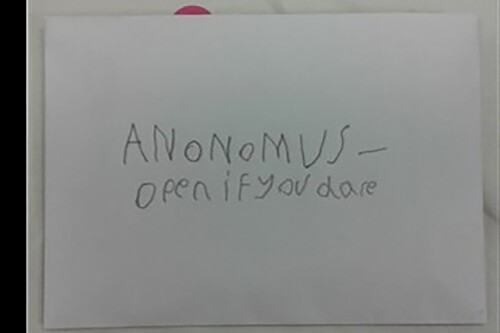
These five sessions occurred over a five-six week period (roughly one session a week). An additional feedback session was then conducted five months later, once transcription and initial analysis of the data had been completed, in order to seek the children’s feedback on, and critique of, the initial analysis of the data. To help prompt the children’s recollections of participating, the lead researcher made individual PowerPoint presentations for each pair, including the photos they had taken on the school tour, photos of their LEGO® models, and clips of sound recordings of their commentary on (or explanation of) their photos and models. The data collection and analysis were conducted by the lead author of this paper guided throughout by the advice and support of the other two authors: therefore, in the analysis and findings sections, the words ‘I’ and ‘me’ are used with first person verbs to illustrate how the children interacted with this researcher.
A short pilot was conducted, to estimate how much time should be allocated for each encounter and to explore the practicalities of the research activities: it was important to not take up too much of the participants’ time or add significantly to their workload. These sessions took place in class time, so that the pupils did not miss their lunch or snack-time (the teachers indicated a time that might be practically possible taking into account considerations such as making sure the research did not clash with the children’s favourite lessons). Furthermore, conducting the research during class time meant that the other pupils were not in the corridors or playground, so the participants could freely take pictures of their school without worrying about having other people in the pictures.
Ethics
The British Education Research Association ethical guidelines were followed (BERA Citation2011, Citation2018). Many of the procedures in the study, such as those around seeking consent, were informed by previous research into the methodological and ethical implications of view-seeking research with autistic children (Scott-Barrett et al. Citation2019). Throughout the research, it was important to offer a non-verbal and visible way for the children to indicate assent or wish to withdraw. Traffic light cards were used to monitor children’s assent to indicate their wishes to continue (green card), pause (orange card) or end (red card) the research encounter.
One participant Seth, wanted to take part in the research and did want to explain what he was photographing and building with LEGO®, but did not want his voice to be recorded. Seth and the lead researcher came up with a system whereby Seth would show the orange traffic light card to pause the recorder, so that he could comment on or explain what he was doing or thinking. In the final feedback session, he explained that he did not like listening to the recorded sound of his own voice or the voices of others.
Analysis
Familiarization with the data was the first phase. This involved close listening to the recordings; looking through the photographs taken of the school and of the LEGO® models; and developing ways to explore the data and ways of communicating the research data and procedures to the participants and future audiences. Throughout this process an analysis journal was kept, to record thoughts and quotes to revisit. Braun and Clarke’s (Citation2006) ‘thorough, inclusive and comprehensive’ (96) process of generating early ideas in analysis was followed: listening, noting down the ideas that arose, the times at which different concepts were mentioned or phenomena occurred. I (JS-B) conducted the first phase of analysis without the transcripts, so that I did not miss important non-verbal sounds that might be relevant to analysis. I organized my initial listening phase by participant (e.g. Struan’s school tour, Struan discussing the photos he took, Struan building his LEGO® model). In this way, I became familiar with the way the children were expressing themselves. During this phase, I used the questions from Srivastava and Hopwood (Citation2009), to deepen my thinking, and to remind me of the active role I had as a researcher in this process of analysis: ‘Q1: What are the data telling me? … Q2: What is it I want to know? … Q3: What is the dialectical relationship between what the data are telling me and what I want to know?’ (78).
Once I had worked through the recorded data, I consulted the children to discuss my initial organization of the data with them, to check and critique the validity of my descriptions (e.g. whether I had heard clearly what the children were saying, and matched the audio-clips up with the correct photographs), as well as asking the children for feedback on how the data were organized and the initial themes. Flewitt (e.g. Citation2005, Citation2006) explains how such early analysis and validation, particularly with younger children in primary school contexts, can help the researcher to appreciate the ‘multiplicity of realities and meanings attributed to any single act by different participants and by the researcher’ (Flewitt Citation2005, 561). This was important, as I wanted to seek my participants’ perspectives on my initial ideas and explore in what ways my participants challenged, agreed with or expanded my initial organization of the data. I wanted their feedback to influence the rest of my analysis (Flewitt Citation2005, Conn Citation2015). I wanted to make sure that if they raised any concerns, I could address those before completing the full process of analysis, and I wanted to use the diverse perspectives that each participant might offer, to encourage me to consider different ways of conceptualizing and organizing my data. Flewitt (Citation2005) highlights the time-consuming nature of taking back early interpretations to participants, and cautions against allowing this to become off-putting or onerous for the participants. Therefore, I consulted the children in only one session, in their original pairs, and made the sessions as easily accessible as possible, with minimal text or writing. I created PowerPoint slides as discussion points, as this was an activity that they were familiar with from the data collection phase. There were several examples of the children correcting initial interpretations: generally I was interpreting the data too literally (e.g. I had misinterpreted a ‘peep hole’ as ‘key hole’ in Steven’s LEGO® model). After these sessions, I revisited all recordings and visual data. The children’s comments and ideas were then integrated into further thematic analysis: the themes were developed according to what was discussed with the children, and initial ideas were reorganized to ensure there was authentic representation of how the children perceived the findings, and what they emphasized that they wanted to share.
Findings
In this section, we discuss five key themes that arose from the data: perceptions of audience; creativity in engagement; diverse demonstrations of control and expertise; enjoyment, engagement and pride; and children’s views on the research process. The findings are presented alongside discussion to illustrate where they extend, challenge or align with previous research in this field. presents the themes in this study and the children whose data are included in this paper as illustrations of each theme.
Table 2. Themes and illustrative data.
Perceptions of audience
With the voice-recorder, it was clear that there were different audiences with whom the children felt they could communicate: Struan liked how the recorder gave him the opportunity to talk to the researcher (we were allowed to tell you about if we had a bad day and stuff like thatFootnote1). Sam liked how it allowed him to talk to himself (At least it gave me a chance to actually talk to myself). Steven talked about hearing himself on the voice-recorder (I like hearing my own voice); Steven also discussed communicating to a wider audience (I do enjoy like showing people all sorts of stuff); and this seemed to resonate with the enthusiasm with which all the participants led the tour, and their anticipation to show me around the school and playground.
Two participants consciously spoke out to me as a future listener, rather than just as a present interlocutor: Steven, by beginning his recording saying Greetings Future ***Name of researcher***. Sam, would regularly apologize to me through the recorder:
I’m sorry if this sounds a bit weird, it’s just the wind is blowing and stuff. It might sound peaceful while I’m here, but it’s probably a pain for you …
Sorry for the delay, I know it must have been annoying for you, so if it was pretty annoying, I apologise for that deeply. But it’s just I sometimes feel like that.
In the photography too, there was some evidence of children imagining an audience:
Here is the middle of the school. It’s kind of in the centre of the school. You can see tyres, you can play here as well. It’s another part of the playground. I hope you enjoyed the video.
So that will be coming out as a photo.
I have always wanted to be a YouTuber and that’s probably why I said, ‘please enjoy the video’!
The two key elements arising from both this research and the work of Worth (Citation2009) are firstly, that efforts are made to be sure that children are clear about who the actual audience will be. This is a crucial aspect of the informed consent process, and is developed through thoughtful communication, rapport building, and clear and accessible explanations of the research processes. Secondly, it underscores that finding ways to provide children some ownership of the process may allow them to feel positively about sharing their views, and to feel control over what they share and how they express their opinions, ideas, narratives and experiences.
Creativity in engagement
Creative engagement with the research process was evident across all the research methods. With the voice-recordings most children appeared to relish the opportunity to use the recorder, and creatively explored the recording possibilities it offered. As well as their voices, children recorded birdsong, piano music and a range of other sounds:
So now we’re just taking a wee walk in the playground. Right, now, let’s see if we can record the wind, the nature. (Jess)
[Sound of tapping metal bars] This is just the iron bars. And that’s interesting what sounds they make. I’ll make sounds for what things are here … So this is like, that is the green swing things, I don’t know what to call them, but they are interesting, they are definitely interesting. You basically just swing, wooo [makes sound as he swings on the swings] wooo. And stuff like that. (Sam)
Creativity was also evident in abundance during the LEGO® building. In some cases, as in the first example here (), the LEGO® models were closely grounded in the children’s experiences in school, in others, as in the second example (), they were a re-imagined version of the school, and in yet others (), they appeared to be a creative invention, rather than reflective of school experiences:
So what can we see in the classroom? [Talking about Jess’s LEGO® model (Figure 2)]
Well there is the Peace Corner (pointing at the green covered area).
Yeah
Where you go if you are distracted.
So which bit of the school was this?
It’s like stadium, football stadium, because it’s a bit boring not being a stadium. Because as you know like the football pitch is a bit too small isn’t it?
Yeah.
It doesn’t really match, go properly. It should be a stadium.
Yeah.
So I wanted to do like a stadium … So this is going be like two, two like layers, in the football stadium. Like there’s one layer here, but that’s going to go down the way.
So are these football stadia in school or outside of school?
In school.
Wait a minute. I’ve not done this in a long time with LEGO®. I can make an invention with this … Yeah this, this almost looks like an invention. Look this almost looks like an invention.
It does look like an invention doesn’t it.
So how am I going to get it to balance?
Ok, so can you tell me a bit more about what you’ve built so far?
So we made a thief, and he’s trying to rob the school by robbing the …
Wait, I want to get some hair on this.
… Legendary steering wheel.
By robbing the legendary steering wheel! Where’s the steering wheel from?
From loose parts play.
Loose parts play.
So he’s like this cos he has, he’s like, ‘I must have it’.
Wait a minute, wait.
Is he successful in his mission
No.
Why, what happens? Saved the day?
Yeah, us two save the day [indicating himself and Jacob].
Ok, so we just paused and one of the participants [Seth] has told me about the classroom that he is building. And he has shown me the teacher that is writing on the smartboard and it’s looking really good.
So he has shown me the teacher writing on the smartboard, he has shown me the man painting the wall or possibly cleaning the windows … He has shown me the indoor bus stop and tree near the bus stop. He has shown me the library corner, the book corner, and he has shown me the class mascot.
This me … Me going to dentist … This is the dentist. And the dentist [inaudible]. Where’s lady, everybody is waiting.
It’s so hard to build the LEGO®, and it would take for like five minutes to draw. It’s so easy because you just need a pencil and colouring, that’s all … Drawing is better than building. Building is just like you keep building building building, like slow, and drawing is like making faster and faster and faster.
The LEGO® system has a low floor, which means it is easy for newcomers to get started, whilst the high ceiling means that more experienced users can work on increasingly complex projects. Most important of all are the wide walls, which mean that creativity and imagination can take a project in innumerable directions. (Gauntlett Citation2015, p. 3)
Figure 2. Jess’ LEGO® model of her classroom. Note: During the LEGO®-building process I (the first author) asked the children about what they were building.
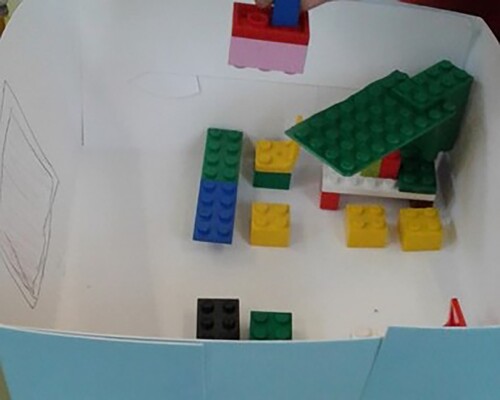
Figure 3. Joel’s LEGO® model of a football stadium.
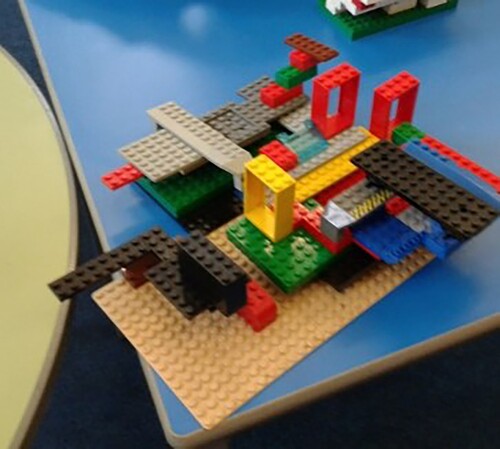
Figure 4. Jacob and James’ LEGO® model.
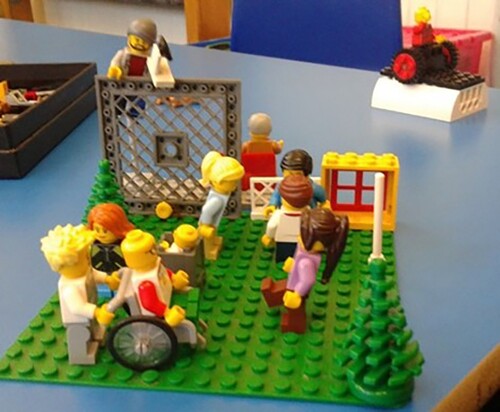
Figure 6. Sophie’s LEGO® Model.
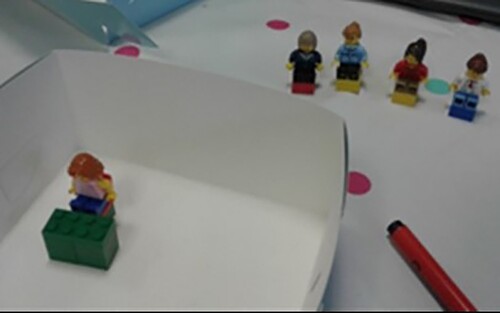
Nonetheless, Gauntlett’s (Citation2015) idea of ‘wide walls’ supporting creativity and imagination are certainly consistent with some of the imagined narratives that would often accompany the building (e.g., the playground thief scene, ). Gauntlett (Citation2015) relates ideas of imagination and creativity with LEGO® to Donald’s (Citation2001) theories on how people externalize and communicate ideas:
Externally displayed thoughts can be assembled into complex arguments much more easily than they can in biological memory. Images displayed in this field are vivid and enduring, unlike the fleeting ghosts of imagination. This enables us to see them clearly, play with them, and craft them into finished products, to a level of refinement that is impossible for an unaided brain. (Donald Citation2001, 309, cited in Gauntlett Citation2015)
Donald’s (Citation2001) ideas align with research into how the visual displays of ideas can support thinking and self-expression through ‘offloading cognition’ onto an external representation (Manches and O’Malley Citation2012), and also by allowing someone to physically manipulate that representation (Larkin and Simon Citation1987), in order to link ideas, or to create new ideas both physically and visually. My examples, such as Joel’s football pitch and Jess’s classroom, do suggest that LEGO® does offer the potential of supporting the children’s discussion of different spaces (in these cases school spaces). It was also interesting to see the children innovate with the LEGO® and make the most of the three-dimensional opportunities it offered (Joel adding two levels to the football pitch, and Jess holding the LEGO® blocks as the smartboard projector above her model). In this sense, the LEGO® did seem to be a helpful tool to stimulate discussions, and particularly discussions about school spaces, engaging the children in creative building, producing complex models that could represent or visualize three dimensions, and positioning the children as knowledgeable about what they had created.
The use of LEGO® also enabled the children to discuss complex or abstract ideas, by focusing on smaller and more manageable elements. For example, Jess could talk through the different areas of her classroom whilst pointing to the model and Joel explained the layout of the different layers of his stadium. The models functioned as a stimuli for conversation, and the LEGO® seemed helpful in terms of facilitating the discussion of abstract ideas as conversations often moved beyond the physical model the child had built.
These findings relate to the discussions in Gripton and Vincent (Citation2021) who suggest that the small world toys enabled children to add imagined elements which added flexibility to their expression:
Small world toy representation provided particular affordances where other methods can be more limited by being more tethered to the present context (for example, photographs or tours of the environment). Using small world toys, children are able to represent absent, imagined or aspirational elements within their school experiences. (236)
In terms of the flexibility afforded, the findings of this theme also resonate with the conclusions of Gripton and Vincent (Citation2021) who argue:
Children were able to use the small world toys to communicate with as well as communicate about. Some children verbalised from the outset of their construction whilst others were quieter, some talked or made noises for the figures and others talked about them (to themselves or to the researcher). In contrast to more traditional interviewing, the small world toys provided the children with time and stimuli with the benefit of not requiring an immediate response. (236)
Diverse demonstrations of control and expertise
Elements of the voice-recorded tour, the photography and the LEGO® building appeared to help give the participants a higher degree of control than might have been the case in a more traditional data collection format such as interview. For example, the children physically having the voice recorder meant that they could make choices about what they wanted to record and whether they even wanted to be recorded: as stated earlier, Seth wanted to take part but not be recorded. He enthusiastically held the recorder, pretending it was a phone, and used the orange card to indicate when he wished to pause the recorder to make a comment. Holding the recorder also meant that the children could record in the playground at a slight distance from the researcher:
Ok. [Whispers:] So this tour has been quite fun.
Do you want me to take the recorder or are you recording secretly?
I’m fine, I’m recording secretly. [Whispers:] So this tour has been quite fun. We are just heading back to our meeting place, our classroom.
I’m recording this.
You’re recording this. Ok cool. So it’s recording at the moment. Do you see the lights there?
So usually people use these for ghost things. They usually like click the buttons and they say: ‘8pm, found ghost in a washing [machine]!’.
Yeah they also use it for diaries, embarrassing secrets. Hey, have you ever had an embarrassing secret?
I think everyone has embarrassing secrets!
What’s your embarrassing secret?
So if you see anything you want to take a photo of …
Should I say ‘Cam’ … short for camera?
Oh yeah, yeah that’s a good idea.
So what do you do behind here?
I just play. So we do this for how long?
As long as you like: we can go inside the school, outside the school, wherever you want, probably about twenty minutes?
Forever!
We can’t do this forever [laughs].
I want to do this forever! This is my favourite bit. Cam!
Issues of ownership and expertise were also evident at the stage of photo interpretation, with implications for data analysis. When looking at the photographs with the children, it was important to remember that they had more knowledge about the photographs than the researcher, and to allow them to be in a position of explaining, as in this example, of Joel and Jack sharing their knowledge about an alley in the playground ():
That’s just a, that’s just like, that’s an alley.
Yeah like this bit is an alley.
That’s an alley and I’ve been in there.
And it’s infested with woodlice.
With woodlice?
Isn’t it infested with woodlice?
Yes, but you can’t see them because they are so tiny.
Yeah the lice are so tiny.
Enjoyment, engagement and pride
The methods used in the research resulted in clear enjoyment, humour, engagement and pride at various points throughout the research.
Yeah, that’s finished recording the birds. So, just want to say, I’ve just used this for 3 minutes and 40 seconds, seriously, this is officially amazing. That’s the sandpit, who wants the sand pit. That’s the sand pit over there. It’s officially AMAZING. Oh yeah, you see that? Look this is a voice-recorder … enjoying that.
This is fun isn’t it.
I know it is yeah. I like it … Well anyway, that clearly, anyway I’m not going to finish recording, because it’s cool [he continues recording animatedly].
Wow. Look at that! [Talking about the photograph of the tree he has just taken ()
That’s a great picture.
Ooo. Wow. That’s cool! Aa I took a picture of the ground!
That’s alright.
Voice-recorder please!
Ok, so why have you chosen to build the fort?
Just cos I think it would be quite easy.
Cool. And do you like playing in the fort?
Mm hm. I also call it the nugget cave.
The nugget cave, why do you call it the nugget cave?
Because my friends call it that.
Is that chicken nuggets or golden nuggets?
Chicken nuggets.
Chicken nuggets [Researcher and Steven both laugh].
We’re doing, we’re doing the photos. Ok that one’s just pixilated.
Yes, it’s a bit blurry isn’t it.
So it looks like it’s probably like raining really, really hard, and it’s painted with lines.
Yes.
That’s just, cos that’s just, cos I think that’s my picture. I was running with the iPad taking a picture.
It looks like a really good work of art by an artist. It looks like …
That was me, I was the artist.
You were the artist, exactly.
Bravo [researcher laughs] …
Oh yeah!
You took beautiful pictures of the tree.
Where’s … I remember that that. I remember. Go back, go back, back, back. I remember, do you remember last time? Actually last time it was very fun, because we get to go outside and talk to you stuffs and get fun. We get to play stuff. My actually, my favourite was actually, my favourite part of the school is actually is at the garden, is actually the secret garden. Because there are lots of fun things.
So your favourite bit is the secret garden?
Yeah because it’s a secret.
You took some amazing photos of the secret garden.
On the whole, we overestimate children academically and underestimate them intellectually, we miss moments when our attention could convey to children that their ideas are important. (Katz Citation1998, p. 38)
Figure 9. Steven’s LEGO® model.
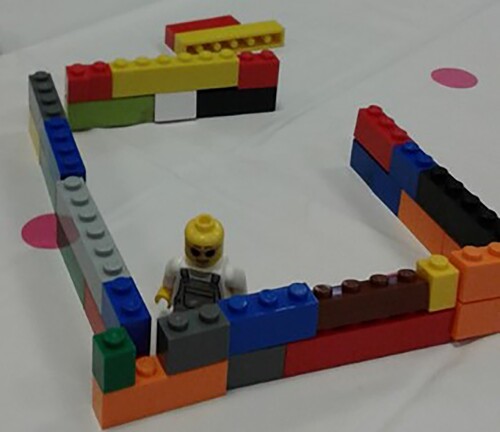
Figure 10. Photograph taken by John.

Figure 11. Photograph taken by Sacha.

The use of children’s blurred photographs provided an important reminder about the balance of power in the research. I nearly deleted the blurred photographs, so as to not include them in the presentation, to allow more time for the children to discuss the photographs that had come out ‘properly’. However, I reflected on why I wanted to delete them, and I decided to include them. This resulted in very interesting discussions: Jess suggested the photograph looked like a work of art, and in a different session, Joel commented that a blurring in his photograph looked like a snow wind. This is another reminder of how important it is to be aware of how easily adult-thinking can affect even small decisions in the research process, which may stifle or restrict what children say. The participants actively reflected on and engaged with their photos and discussed them, even if there were no clear objects or elements of scenery visible. Therefore, it was important not to make a judgement on the value or meaning of a photograph before showing the children, as had I deleted them the rich and interesting discussions would not have occurred.
Children’s views on the research process
The children shared their views on the research process during the research itself, but also via the reflection sessions and feedback sheets at the end of the research. During my discussions with the children and in the feedback sheets, whilst there was a little negative or critical feedback, their reflections about the research were generally very positive.
I loved where we took pictures of the playground. We were allowed to, we were allowed to tell you about if we had a bad day and stuff like that.
Yes
And we did research and that stuff … . The bits which were interesting, were where we were typing up and then we just had to like, we were trying to like think. You know, think a lot about it. How like, ‘Oh this is M and T [Music and Technology]’, like ‘Oh this is the school, and that’s the tree, this is a building. This is the family room’, and things like that.
So you liked it when we were looking at the photos and typing.
Yeah because it was actually like from like your head [he taps his head].
Hang on. Almost done. Done!
Oh great.
Can I tell you what it is?
[reading the text below the emoji] ‘because you love’, what’s ‘them’?
Pictures … .And guess what emoji that is.
Which one?
Oh it’s, it’s the one that has the face and its, and its eyes are love hearts.
Sunglasses, so the cool emoji.
I love that.
And can you write the word that this emoji signifies? So what does that signify?
Happy. Actually, you know what. … [in funny voice] Love it!
You love what?
[in funny voice] The LEGO®, I love LEGO®
It’s a smile [he says this while drawing a long line stretching from the mouth across the full page]
Why is it helpful? You can be honest. You can say it’s actually not helpful.
Because I like LEGO® because I like building.
You like building, ok.
I like building.
And does it help talk or does it not help talk?
It helps, it helps remind me of stuff. And I can play with it with my mini-figures.
Is there anything you would like to say about the school or about your LEGO® model?
It was good, though from LEGO® I’d rather do, like we play on the smartboard there.
You’d rather the smartboard, Ok. What, you’d prefer that to LEGO® or you’d like to do both?
I’d prefer that to LEGO®.
Was there anything you would have rather done instead?
Probably like taken videos, without people inside.
Videos without people, that’s a good idea!
Just a voice.
Ok, that’s a good idea!
Did you enjoy doing this or would you rather have done something different?
Well I like, I like doing, enjoy doing this, but next time can we do travel around the world instead?
What, travel around the …
No, like travel like to other places in Scotland to see how their, how their school’s doing. And you can go to my cousin’s school. He’s really nice. He’s a really nice chap mate.
So, what, you would rather, rather than doing LEGO®, you would rather go to a different school and visit them?
Yeah then we can build LEGO®, then we can build [with] my cousin …
Figure 12. Emoji drawn by John.
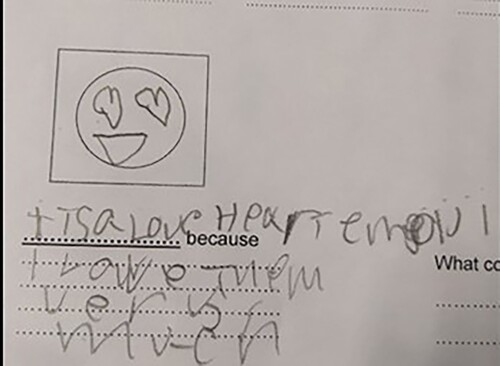
Figure 13. Emoji drawn by James.
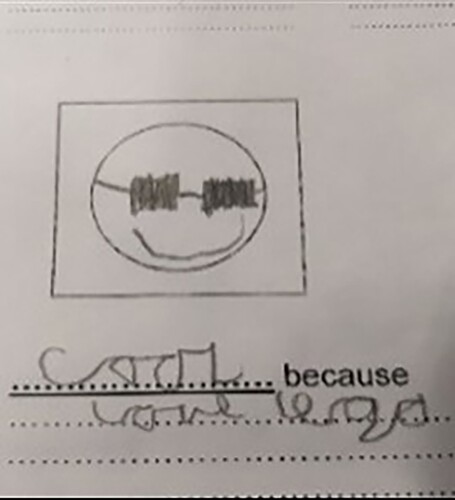
Figure 14. Emoji drawn by Joel.
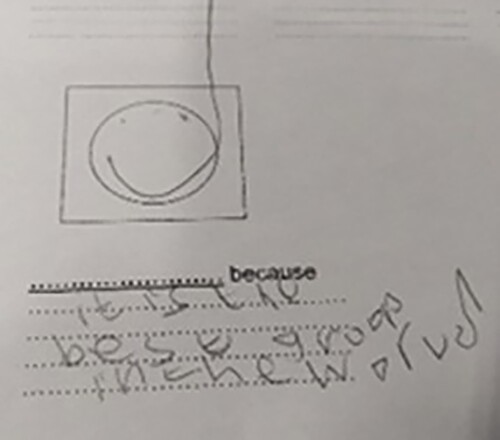
The feedback sheets had mixed success: in most cases participants used them to provide feedback of direct relevance to the different elements of the research. However, in some cases, the children’s feedback did not relate to the research. For example, Sam drew what he described as ‘the worst possible version of a demon’ emoji (), and explained that it did not relate to the LEGO® research session they were previously discussing.
Sophie preferred to highlight the questions ():
Look!
Brilliant!
It’s too smelly that pen. Eurgh.
Figure 16. Sophie’s feedback sheet.

Children also demonstrated understanding of the ethical elements of the research during the data collection process: the children would often remind each other (or themselves) not to take photos with people:
… Let’s take a photo of here. Where there isn’t any people. Oh wait, now we can do it.
It is important to recognize that the process of eliciting feedback included some drawing but mainly spoken and written feedback and we acknowledge this as a limitation. In gathering feedback, it was important to be attentive to the great variety in the children’s use of language, ensuring we represented diverse views and so included feedback from those who had highly expressive written and spoken language as well as those who had more limited vocabulary and expressions, as all feedback was useful. Nonetheless we recognize this is a limitation and encourage further research into how to meaningfully elicit participant feedback on methods and research processes.
Reviews have highlighted the need for diversity in the way that feedback is sought (Borland et al. Citation2001, Hill Citation2006), and although there was previously a gap in the literature seeking children’s views on research methods (Hill Citation2006, Gillies and Robinson Citation2012, Hadfield-Hill and Horton Citation2014), a recent study by Simpson et al. (Citation2022) underscored that seeking feedback from young participants is both possible and highly valuable. Simpson et al. (Citation2022) conducted research with four autistic children using a video-recording device to enable the children to record and describe their experiences and a follow-up interview was conducted for reflection and feedback; in the interview their participants commented on both the activities they recorded on the video (e.g. commenting on what they were doing or concentrating on), and also commented on the data collection methods: ‘Matt commented that he liked the filming and found this fun. Chloe liked that they were asked to video the activities rather than to talk to someone about the activities’ (Citation2022, 1706). Their participants, similar to the participants in this present study, offered insightful and reflective comments on the data collection emphasizing that seeking children’s views is both possible and valuable.
When seeking feedback, power dynamics is a real concern, as I wanted to make sure that participants could give feedback freely, so I provided the option for them to fill in the form anonymously so that they did not have to tell me directly. Four children chose to fill in the forms away from my vision, and put them in an envelope in a feedback box. This may also suggest the value of asking someone else (a teaching assistant or someone that the children feel able to interact with) to help the children with reading the feedback forms, and to collect the forms. Even though some of the children did not fully engage with the feedback process in the way that a researcher might have hoped (for example, Sam drawing an emoji that was not a reflection on the research, or Sophie wanting to just highlight the questions), these were self-expressions in themselves.
These expressions offer interesting insights into power in research: if you really want to hand over some control to the children and encourage creativity and free expression, then you need to be prepared for, and welcoming of, the unexpected. It is also important to reflect on how this feedback may not teach us about what we hoped for, but may contribute to understanding in a different way; for example, in Sophie’s case, she explained to me that the pen was ‘too smelly’. This reinforces the need for researchers to take into account the sensory details of not only the context of a research encounter, but also the sensory details of the activities, equipment and materials. It was important to check with each participant that the equipment and materials were both accessible and useful.
Discussion
This study aimed to explore approaches which help researchers to engage with autistic children’s views in meaningful ways, and to find out more about autistic children’s self-expression and engagement in multimodal research. In doing so, it responded to Hill’s call (Citation2006) for further research into children’s views on methods to obtain and engage with children’s perspectives. We examined the different ways that the children expressed their ideas, and interacted with the research materials, the researcher and their peers.
In terms of engagement with research activities, the data show glimpses of how the children engaged with the different research activities as well as how they interacted with me as researcher, especially in terms of what they chose to show me in their surroundings. The multimodal approach seemed useful in this study, as it created opportunities for different modes of expression allowing for creative communication without having to rely just on one expressive form; furthermore, the multi-method element meant that children could compare and explain how they found the different methods, and discuss which elements they did or did not enjoy, allowing them to reflect on and critique the different activities. The evidence offers a refreshing counter to the often deficit framing of autistic children’s self-expression. The data show the children skilfully forming, expressing and sharing their views, and reflecting on their experience of the research.
To reflect critically on this research process it is helpful to emphasize that frequently, ‘less reliance on verbal skill’ is highlighted as a key strength of visual methodologies such as modelling or photo elicitation (see for example Shaw Citation2021). However, in this research, even though the children did communicate through multiple modalities, there was still a strong reliance on oral competency and different approaches would certainly be more appropriate for those who did not, or preferred not to, use much or any spoken language (see, for example Greathead et al. Citation2016, Hill et al. Citation2016, Doak Citation2019). Furthermore, with more time it would have been helpful to create opportunities for deeper participation in the co-creation of methods and research foci: Fletcher-Watson et al. (Citation2019) argue: ‘Open dialogue about the focus and methods of research, with autistic people and their allies who are not researchers, can not only help to contextualise the work but also educate communities about the realities of the research process’ (pp. 949–950).
The findings emphasized the importance of acknowledging power dynamics when exploring children’s self-expression and engagement with different activities: especially in terms of the way power differentials between children/adults and researcher/participant can determine who controls what is discussed or created, and can highlight differences in knowledge, and expertise. The findings from this research seem to suggest that the more control and power we hand over to the children, the more meaningful the processes and interaction may become to the children and the more engaged they may be with the process: by giving the children control over the voice-recorders, tablet (to take photographs), LEGO® bricks, and traffic light cards, we offered them the opportunity to engage, but also the opportunity to creatively use the equipment however they wished, to focus the researcher’s attention on whatever the children perceived as important or interesting. This resonates with research that has been conducted more broadly with children (e.g. Clark Citation2010, Lomax Citation2012) and with research such as Spiel et al. (Citation2020)’s reflections on power dynamics in research with autistic young people and the role of the researcher to apply ethical reflectivity in-situ, and reflect on where the attention of the researcher and the group is being directed and how that can exacerbate or ameliorate the power dynamic in research encounters. Attending closely to micro and macro power differentials in research lays important groundwork toward meaningful and respectful research interactions. Parsons et al. (Citation2022) highlight that the onus lies on researchers to find ways to listen to and learn about autistic school experiences, to collaboratively co-construct evidence and to include autistic children in educational research and decision-making, they explain ‘This means being creative about how voices are respected and represented, and competencies nurtured and enabled’ (1072).
Furthermore, this research extended this discussion by providing illustrations of how supporting autistic children’s ownership of research materials and processes might support their engagement in the research. This handing over of power may take the form of physical manifestations such as the handing over of voice-recorders, or cameras, or indeed more abstract acts, such as allowing the children to choose the topic of discussion, to critique the methods and to ask questions rather than just respond to them. However, it is worth noting that the act of ‘handing over’ ownership positions the adult as instigator of the research – co-creation of research from the outset would enable children’s greater ownership from a much earlier stage (Gallagher Citation2008).
The data in this study are inevitably limited, as they relate to researchers’ interactions with specific individuals in particular contexts. However, it is hoped that other researchers can use the advice and real-life examples presented here, to interrogate and develop their own practice, and consider how these issues and opportunities may manifest themselves in their own particular settings, and within their own research interactions. Furthermore, the children in this research all were all young people who used written and spoken language as their primary means of communication in school, if there had been children who did not, or preferred not, to use language in the two schools, they would of course have had the opportunity to participate if they wished, and the methods would have been adapted according to their communication preferences. For important detail on seeking the views of children who do not use (or prefer not to use) written and spoken language as a primary means of communication see Doak (Citation2019) who proposes a ‘hybridized approach’ to multimodal research, Hill et al. (Citation2016) and Greathead et al. (Citation2016). It is important to underscore that all approaches must be adapted to be respectful of individuals preferred communication modes, and must be responsive to the communicative cues and wishes of those involved.
Conclusion
This research sought to communicate to the children throughout that their views were valued and valuable. It also aimed to provide opportunities where the child was positioned as the expert and the researcher was positioned as more unknowing (such as the playground tours), and where the child was positioned as the creator (such as the LEGO®), allowing them to assume a position that was comparatively more powerful and knowledgeable, and encouraging them to both recognize and share their expertise.
This paper hopes to contribute to three of the key themes that run through recent literature:
Diverse approaches: it is important to develop a diversity of approaches so that autistic young people can share and explain their ideas, experiences and views in ways that suit their communicative preferences and interests. Different methods may be more or less helpful as different topics come into focus, and researchers must strive to develop more and multiple meaningful ways to listen to the views of autistic children and young people (e.g. Crane et al. Citation2019, Citation2021, Goodall Citation2020, Warren et al. Citation2021, Hummerstone and Parsons Citation2022).
Meaningful research activities and foci: the research foci and activities should be relevant and meaningful to research participants – this may result in multiple research foci as the participants direct researchers’ attention to elements that are important to them and their lives (Goodall and MacKenzie Citation2019, Goodall Citation2020, Tomlinson et al. Citation2020, Cunningham Citation2022). Research activities need to adapt to ensure they are worthwhile, interesting and valuable to participants and research must communicate that the participants’ contributions are valued and valuable (Fletcher-Watson et al. Citation2019).
Respectful research practices and processes: all elements of research should communicate sincere respect to the participants involved and to the broader autistic community (Long et al. Citation2017, Fletcher-Watson et al. Citation2019, Citation2021, Bottema-Beutel et al. Citation2021, Parsons et al. Citation2022). The theoretical frameworks of double empathy (Milton Citation2012) and autistic expertise (Milton Citation2014) can provide helpful grounding for conceptualizing research interactions: Milton (Citation2014) emphasizes the ethical imperative to ‘appreciate the distinctive knowledge autistic people possess and to build more constructive ways of relating to it’ (798). A positive means of ensuring autistic children are engaged respectfully in research is recognizing their authority and expertise in reflecting on their lived-experiences, and also their insight in commenting on research methods and processes: a helpful way of integrating this is ensuring children are given the opportunities to co-design, adapt, comment on, take control of and/or feedback on methods, as this is an important step in finding ways for meaningful communication and interaction. This also strongly underscores the need for deficit-framing to be replaced by a strength-based approach where participant strengths are recognized and valued (Gaudion and Pellicano Citation2016).
The findings emphasize the importance of developing a flexible research design, with multiple opportunities for self-expression through different modes (which can be adapted to suit individuals’ strengths and needs). Such design can offer children choice over how they wish to express themselves, flexibility over the pace (and if possible, topic) of research interactions, and opportunities to express choice and expertise. By doing this, children might be able to indicate to the researcher how research could be made more meaningful to them. Furthermore, mindful of the double empathy framework (Milton Citation2012), the design must allow us as researchers to communicate effectively that it is the young person’s opinions, creations and expertise that are sought and valued.
Acknowledgements
This research is indebted to the hard-work and enthusiasm of its participants, to their patience in sharing their advice and creations with the research team, and to the energy and joy they brought to the research. We are sincerely grateful to school staff, especially the Heads of Support for Learning, and the participants' families, for their support throughout the research. We would also like to thank the reviewers for their very helpful comments and advice.
Disclosure statement
No potential conflict of interest was reported by the author(s).
Correction Statement
This article has been corrected with minor changes. These changes do not impact the academic content of the article.
Additional information
Funding
Notes
1 Pupil comments are italicised when if they were spoken, and non-italic if they were written or typed.
References
- Beresford, B., et al., 2004. Developing an approach to involving children with autistic spectrum disorders in a social care research project. British journal of learning disabilities, 32 (4), 180–185. doi:10.1111/j.1468-3156.2004.00318.x
- Borland, M., et al., 2001. Improving consultation with children and young people in relevant aspects of policy-making and legislation in Scotland. Edinburgh: The Scottish Parliament. Available from: https://archive.parliament.scot/business/committees/historic/education/reports-01/edconsultrep02.htm [Accessed 24 March 2019].
- Bottema-Beutel, K., et al., 2021. Avoiding ableist language: suggestions for autism researchers. Autism in adulthood, 3 (1), 18–29. doi:10.1089/aut.2020.0014
- Braun, V. and Clarke, V., 2006. Using thematic analysis in psychology. Qualitative research in psychology, 3 (2), 77–101. doi:10.1191/1478088706qp063oa
- British Education Research Association, 2011. Ethical guidelines for educational research. Available from: https://www.bera.ac.uk/researchers-resources/publications/bera-ethical-guidelines-for-educational-research-2011.
- British Education Research Association, 2018. Ethical guidelines for educational research, fourth edition. Available from: https://www.bera.ac.uk/researchers-resources/publications/ethical-guidelines-for-educational-research-2018.
- Clark, A., 2010. Young children as protagonists and the role of participatory, visual methods in engaging multiple perspectives. American journal of community psychology, 46 (1–2), 115–123. doi:10.1007/s10464-010-9332-y
- Clark, A., 2017. Listening to young children: A guide to understanding and using the mosaic approach. 3rd ed. London: Jessica Kingsley.
- Collier, M., 2001. Approaches to analysis in visual anthropology. In: T.V. Leeuwen and C. Jewitt, eds. The handbook of visual analysis. London: SAGE, 35–60.
- Conn, C., 2015. Essential conditions for research with children with autism: issues raised by two case studies. Children & society, 29 (1), 59–68. doi:10.1111/chso.12018
- Corsaro, W.A. and Molinari, L., 2012. Entering and observing in children’s worlds: a reflection on a longitudinal ethnography of early education in Italy. In: P. Christensen, ed. Research With children. London: Routledge, 191–212.
- Crane, L., et al., 2019. ‘Something needs to change’: mental health experiences of young autistic adults in England. Autism, 23 (2), 477–493. doi:10.1177/1362361318757048
- Crane, L., et al., 2021. ‘We aren’t given the same chances’: autistic young people’s experiences of transitioning to adulthood following the children and families Act 2014. British educational research journal. doi:10.31219/osf.io/s9epd
- Crompton, C.J., et al., 2021. Double empathy: why autistic people are often misunderstood. In: E. Cage and D. Serbic, eds. What does it mean to have an invisible condition? Frontiers for Young Minds. doi:10.3389/978-2-88971-796-5
- Cunningham, M., 2022. ‘This school is 100% not autistic friendly!’ Listening to the voices of primary-aged autistic children to understand what an autistic friendly primary school should be like. International journal of inclusive education, 26 (12), 1211–1225. doi:10.1080/13603116.2020.1789767
- Cusack, J. and Sterry, R., 2016. Your questions: shaping future autism research. London: Autistica. Available from: https://www.autistica.org.uk/downloads/files/Autism-Top-10-Your-Priorities-for-Autism-Research.pdf
- Danker, J., Strnadová, I., and Cumming, T.M., 2017. Engaging students with autism spectrum disorder in research through participant-driven photo-elicitation research technique. Australasian journal of special education, 41 (1), 35–50. doi:10.1017/jse.2016.7
- Dicks, B., et al., 2011. Multimodality and ethnography: working at the intersection. Qualitative research, 11 (3), 227–237. doi:10.1177/1468794111400682
- Doak, L., 2019. ‘But I’d rather have raisins!’: exploring a hybridized approach to multimodal interaction in the case of a minimally verbal child with autism. Qualitative research, 19 (1), 30–54. doi:10.1177/1468794117752115
- Donald, M., 2001. A mind so rare: the evolution of human consciousness. New York, NY: W W Norton & Co.
- Ellis, J., 2017. Researching the social worlds of autistic children: an exploration of how an understanding of autistic children’s social worlds is best achieved. Children & Society, 31 (1), 23–36. doi:10.1111/chso.12160
- Fayette, R. and Bond, C., 2018. A systematic literature review of qualitative research methods for eliciting the views of young people with ASD about their educational experiences. European Journal of Special Needs Education, 33 (3), 349–365. doi:10.1080/08856257.2017.1314111
- Fletcher-Watson, S., et al., 2019. Making the future together: shaping autism research through meaningful participation. Autism, 23 (4), 943–953. doi:10.1177/1362361318786721.
- Fletcher-Watson, S., et al., 2021. Inclusive practices for neurodevelopmental research. Current Developmental Disorders Reports, 8 (2), 88–97. doi:10.1007/s40474-021-00227-z
- Fletcher-Watson, S. and Happé, F., 2019. Autism: a new introduction to psychological theory and current debate. New York: Routledge.
- Flewitt, R., 2005. Conducting research with young children: some ethical considerations. Early child development and care, 175 (6), 553–565. doi:10.1080/03004430500131338
- Flewitt, R., 2006. Using video to investigate preschool classroom interaction: education research assumptions and methodological practices. Visual communication, 5 (1), 25–50. doi:10.1177/1470357206060917
- Foreman, N., et al., 2003. Spatial knowledge of a real school environment acquired from virtual or physical models by able-bodied children and children with physical disabilities. Journal of experimental psychology: applied, 9 (2), 67–74. doi:10.1037/1076-898X.9.2.67
- Gallacher, L.-A. and Gallagher, M., 2008. Methodological immaturity in childhood research?: thinking through ‘participatory methods’. Childhood, 15 (4), 499–516. doi:10.1177/0907568208091672.
- Gallagher, M., 2008. ‘Power is not an evil’: rethinking power in participatory methods. Children’s Geographies, 6 (2), 137–150. doi:10.1080/14733280801963045
- Gaudion, K. and Pellicano, L., 2016. The triad of strengths: a strengths-based approach for designing with autistic adults with additional learning disabilities. In: International conference of design, user experience, and usability, edited by A. Marcus, Cham: Springer, 266–280.
- Gauntlett, D. 2015. The LEGO System as a tool for thinking, creativity, and changing the world. In Making media studies: the creativity turn in media and communications studies. Available from: http://davidgauntlett.com/wp-content/uploads/2014/03/Gauntlett-LEGO-tool-for-thinking-chapter.pdf
- Gauntlett, D., Ackermann, E., and Weckstrom, C., 2009. Defining systematic creativity. Denmark: Billund LEGO Foundation.
- Gillies, V. and Robinson, Y., 2012. Developing creative research methods with challenging pupils. International journal of social research methodology, 15 (2), 161–173. doi:10.1080/13645579.2012.649407
- Goodall, C., 2020. Inclusion is a feeling, not a place: a qualitative study exploring autistic young people’s conceptualisations of inclusion. International journal of inclusive education, 24 (12), 1285–1310. doi:10.1080/13603116.2018.1523475
- Goodall, C. and MacKenzie, A., 2019. What about my voice? Autistic young girls’ experiences of mainstream school. European journal of special needs education, 34 (4), 499–513. doi:10.1080/08856257.2018.1553138
- Greathead, S., et al., 2016. Supporting children with severe-to-profound learning difficulties and complex communication needs to make their views known: observation tools and methods. Topics in Language Disorders, 36 (3), 217–244. doi:10.1097/TLD.0000000000000096
- Gripton, C. and Vincent, K., 2021. Using small world toys for research: a method for gaining insight into children’s lived experiences of school. International journal of research & method in education, 44 (3), 225–240. doi:10.1080/1743727X.2020.1753692
- Guldberg, K., 2010. Educating children on the autism spectrum: preconditions for inclusion and notions of ‘best autism practice’ in the early years. British journal of special education, 37 (4), 168–174. doi:10.1111/j.1467-8578.2010.00482.x
- Ha, V.S. and Whittaker, A., 2016. ‘Closer to my world’: children with autism spectrum disorder tell their stories through photovoice. Global public health, 11 (0), 546–563. doi:10.1080/17441692.2016.1165721
- Hadfield-Hill, S. and Horton, J., 2014. Children’s experiences of participating in research: emotional moments together? Children’s geographies, 12 (2), 135–153. doi:10.1080/14733285.2013.783985
- Harrington, C., et al., 2014. Engaging young people with autism spectrum disorder in research interviews. British journal of learning disabilities, 42 (2), 153–161. doi:10.1111/bld.12037
- Hill, M., 2006. Children’s voices on ways of having a voice: children’s and young people’s perspectives on methods used in research and consultation. Childhood, 13 (1), 69–89. doi:10.1177/0907568206059972
- Hill, V., et al., 2016. Research methods for children with multiple needs: developing techniques to facilitate all children and young people to have ‘a voice’. Educational & child psychology, 33 (3), 27. The British Psychological Society Online.
- Hummerstone, H. and Parsons, S., 2022. Co-designing methods with autistic students to facilitate discussions of sensory preferences with school staff: exploring the double empathy problem. International journal of research & method in education, 1–13. doi:10.1080/1743727X.2022.2071864
- Humphrey, N. and Lewis, S., 2008. ‘Make me normal’ the views and experiences of pupils on the autistic spectrum in mainstream secondary schools. Autism, 12 (1), 23–46. doi:10.1177/1362361307085267
- James Lind Alliance. 2016. Autism top 10. Available from: http://www.jla.nihr.ac.uk/priority-setting-partnerships/autism/top-10-priorities/.
- Jewitt, C., 2008. Multimodality and literacy in school classrooms. Review of research in education, 32 (1), 241–267. doi:10.3102/0091732X07310586
- Katz, L., 1998. What can we learn from Reggio Emilia?, edited by C. Edwards, L. Gandini, and G.E. Forman, eds. The hundred languages of children: the Reggio Emilia approach–advanced reflections, 27–45. London: Greenwood Publishing Group.
- Kirby, A.V., Dickie, V.A., and Baranek, G.T., 2015. Sensory experiences of children with autism spectrum disorder: In their own words. Autism, 19 (3), 316–326. doi:10.1177/1362361314520756.
- Kress, G.R., 2010. Multimodality: a social semiotic approach to contemporary communication. London: Taylor & Francis.
- Lamb, P., Firbank, D., and Aldous, D., 2016. Capturing the world of physical education through the eyes of children with autism spectrum disorders. Sport, education and society, 21 (5), 698–722. doi:10.1080/13573322.2014.941794.
- Larkin, J.H. and Simon, H.A., 1987. Why a diagram is (sometimes) worth ten thousand words. Cognitive science, 11 (1), 65–100. doi:10.1111/j.1551-6708.1987.tb00863.x
- Lindh, J. and Holgersson, T., 2007. Does Lego training stimulate pupils’ ability to solve logical problems? Computers & education, 49 (4), 1097–1111. doi:10.1016/j.compedu.2005.12.008
- Linklater, H., 2006. Listening to learn: children playing and talking about the reception year of early years education in the UK. Early years, 26 (1), 63–78. doi:10.1080/09575140500507868
- Literat, I., et al., 2018. Toward multimodal inquiry: opportunities, challenges and implications of multimodality for research and scholarship. Higher education research & development, 37 (3), 565–578. doi:10.1080/07294360.2017.1389857
- Lomax, H., 2012. Shifting the focus: children’s image-making practices and their implications for analysis. International journal of research & method in education, 35 (3), 227–234. doi:10.1080/1743727X.2012.713932
- Long, J., et al., 2017. Enabling voice and participation in autism services: using practitioner research to develop inclusive practice. Good autism practice, 18 (2), 6–1.
- Loyd, D., 2013. Obtaining consent from young people with autism to participate in research. British journal of learning disabilities, 41 (2), 133–140. doi:10.1111/j.1468-3156.2012.00734.x
- Loyd, D., 2015. Gaining views from pupils with autism about their participation in drama classes. British journal of learning disabilities, 43 (1), 8–15. doi:10.1111/bld.12078
- Makin, C., Hill, V., and Pellicano, E., 2017. The primary-to-secondary school transition for children on the autism spectrum: a multi-informant mixed-methods study. Autism & developmental language impairments, 2, 2396941516684834. doi:10.1177/2396941516684834
- Manches, A. and O’Malley, C., 2012. Tangibles for learning: a representational analysis of physical manipulation. Personal and ubiquitous computing, 16 (4), 405–419. doi:10.1007/s00779-011-0406-0
- Martin, N. and Milton, D., 2017. Supporting the inclusion of autistic children. In: G. Knowles, ed. Supporting inclusive practice and ensuring opportunity is equal for all. Abingdon: Routledge, 111–124.
- Miller, A., 2020. Disabled girls of color excavate exclusionary literacy practices and generate promising sociospatial-textual solutions. International journal of qualitative studies in education. doi:10.1080/09518398.2020.1828649
- Milton, D., 2012. On the ontological status of autism: the ‘double empathy problem’. Disability & society, 27 (6), 883–887. doi:10.1080/09687599.2012.710008
- Milton, D., 2014. Autistic expertise: a critical reflection on the production of knowledge in autism studies. Autism, 18 (7), 794–802. doi:10.1177/1362361314525281
- Moss, J. and Pini, B., 2016. Introduction. In: J. Moss and B. Pini, eds. Visual research methods in educational research, 1–11. doi:10.1057/9781137447357_1
- O’Neill, J.L., 1998. Family and personal section: autism: isolation not desolation-a personal account. Autism, 2 (2), 199–204. doi:10.1177/1362361398022007
- Parsons, S., et al., 2021. ‘Seeing is believing’: exploring the perspectives of young autistic children through digital stories. Journal of early childhood research. doi:10.1177/1476718X20951235
- Parsons, S., Kovshoff, H., and Ivil, K., 2022. Digital stories for transition: co-constructing an evidence base in the early years with autistic children, families and practitioners. Educational review, 74 (6), 1063–1081.
- Pimlott-Wilson, H., 2012. Visualising children’s participation in research: Lego Duplo, rainbows and clouds and mood boards. International journal of social research methodology, 15 (2), 135–148. doi:10.1080/13645579.2012.649410
- Punch, S., 2002. Research with children: the same or different from research with adults? Childhood, 9 (3), 321–341. doi:10.1177/0907568202009003005.
- Raman, S. and French, T., 2021. Enabling genuine participation in co-design with young people with learning disabilities. CoDesign, 1–17. doi:10.1080/15710882.2021.1877728
- Resnick, M. and Silverman, B. 2005. Some reflections on designing construction kits for kids. Proceeding of the 2005. Conference on Interaction Design and Children - IDC ‘05, 117–122. Available from: https://doi.org/10.1145/1109540.1109556
- Rinaldi, C., 2001. A pedagogy of listening: a perspective of listening from Reggio Emilia. Children in Europe, 1, 2–5.
- Scott-Barrett, J., Cebula, K., and Florian, L., 2019. Listening to young people with autism: learning from researcher experiences. International journal of research & method in education, 42 (2), 163–184. doi:10.1080/1743727X.2018.1462791
- Shaw, P.A., 2021. Photo-elicitation and photo-voice: using visual methodological tools to engage with younger children’s voices about inclusion in education. International journal of research & method in education, 44 (4), 337–351.
- Shepherd, J., 2015. ‘Interrupted interviews’: listening to young people with autism in transition to college. Exchanges: the Warwick research journal, 2 (2), 249–262. Available from: https://exchanges.warwick.ac.uk/issue/view/7
- Simpson, K., Imms, C., and Keen, D., 2022. The experience of participation: eliciting the views of children on the autism spectrum. Disability and rehabilitation, 44 (9), 1700–1708. doi:10.1080/09638288.2021.1903100
- Sinclair, J. 1993. Don’t mourn for us. Available from: http://www.autreat.com/dont_mourn.html [accessed 15 July 2017].
- Spiel, K., et al., 2020. In the details: the micro-ethics of negotiations and in-situ judgements in participatory design with marginalised children. CoDesign, 16 (1), 45–65. doi:10.1080/15710882.2020.1722174
- Srivastava, P. and Hopwood, N., 2009. A practical iterative framework for qualitative data analysis. International journal of qualitative methods, 8 (1), 76–84. doi:10.1177/160940690900800107
- Tisdall, E., 2015. Children and young people’s participation: a critical consideration of article 12. In: W Vandenhole, E Desmet, D Reynaert, and S Lembrechts, eds. Routledge international handbook of children’s rights studies. London: Routledge, 185–200. doi:10.4324/9781315769530.ch11
- Tomlinson, C., Bond, C., and Hebron, J., 2020. The school experiences of autistic girls and adolescents: a systematic review. European journal of special needs education, 35 (2), 203–219.
- United Nations Committee on the Rights of the Child (UNCRC), 1989. Convention on the rights of the child. New York: UN.
- United Nations Committee on the Rights of the Child (UNCRC), 2009. General Comment No. 12: The Right of the Child to be Heard. Available from: https://www2.ohchr.org/english/bodies/crc/docs/advanceversions/crc-c-gc-12.pdf
- Vasalou, A., et al., 2021. On power and participation: reflections from design with developmentally diverse children. International journal of child-computer interaction, 27, 100241. doi:10.1016/j.ijcci.2020.100241
- Warren, A., Buckingham, K., and Parsons, S., 2021. Everyday experiences of inclusion in primary resourced provision: the voices of autistic pupils and their teachers. European journal of special needs education, 36 (5), 803–818. doi:10.1080/08856257.2020.1823166
- Winstone, N., et al., 2014. Eliciting rich dialogue through the use of activity-oriented interviews: exploring self-identity in autistic young people. Childhood, 21 (2), 190–206. doi:10.1177/0907568213491771
- Wood, R., 2020. The wrong kind of noise: understanding and valuing the communication of autistic children in schools. Educational review, 72 (1), 111–130. doi:10.1080/00131911.2018.1483895
- Worth, N., 2009. Making use of audio diaries in research with young people: examining narrative, participation and audience. Sociological research online, 14 (4), 77–87. doi:10.5153/sro.1967
- Ytterhus, B. and Åmot, I., 2021. Kindergartens: inclusive spaces for all children? International journal of inclusive education, 1–17. doi:10.1080/13603116.2021.1950976

